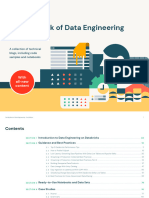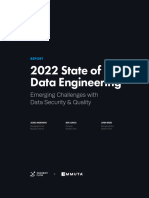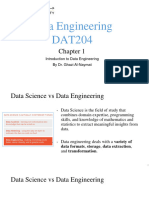Evolution of Data Engineer
1. Pre-Big Data Era (Before 2000s)
Data Architects and Database Administrators (DBAs): Before the era of big data, the
role of managing data was typically handled by DBAs and Data Architects. These
professionals were responsible for designing, maintaining, and securing databases,
focusing mainly on structured data in relational databases.
Focus: Ensuring data was stored efficiently and was easily accessible for querying using
SQL. Data pipelines were minimal, and data volumes were not as large as they are today.
2. The Big Data Revolution (Early 2000s – 2010s)
Introduction of Big Data Technologies: With the advent of technologies like Hadoop,
MapReduce, and NoSQL databases (e.g., Cassandra, MongoDB), the complexity and
scale of data grew exponentially. Data engineers began to play a more significant role in
setting up distributed data systems.
Role Evolution: The responsibilities expanded to include building and maintaining large-
scale data infrastructure, handling unstructured and semi-structured data, and integrating
data from a variety of sources.
Data Pipelines: Data engineers began focusing on the creation of robust ETL (Extract,
Transform, Load) pipelines to process and move data efficiently. Real-time data
processing tools such as Apache Kafka and Apache Spark also became essential during
this period.
3. Cloud Era and Data Warehousing (2010s)
Cloud Services: The rise of cloud platforms such as AWS, Google Cloud, and Azure
introduced a shift from on-premises infrastructure to cloud-based services. Cloud-based
storage (e.g., Amazon S3, Google BigQuery) and managed data warehouses allowed for
scalability without the constraints of traditional data centers.
Data Lakes: The concept of a data lake—a centralized repository for storing structured,
semi-structured, and unstructured data—became prominent. Data engineers were tasked
with building and managing these data lakes, ensuring that data was available in its raw
form and could be processed in various ways.
ETL to ELT Shift: As cloud platforms improved, there was a shift from the traditional
ETL (Extract, Transform, Load) model to ELT (Extract, Load, Transform), allowing for
faster data ingestion and more flexibility in data processing.
4. Rise of Real-Time and Streaming Data (Late 2010s)
Real-Time Data: With increasing demand for real-time analytics, data engineers began
focusing on technologies that supported real-time data processing, such as Apache
Kafka, Apache Flink, and Apache Pulsar.
Microservices Architecture: Data engineers started working more closely with software
engineers to build data pipelines that could integrate seamlessly with microservices
architectures. The role of data engineer began overlapping with DevOps and site
reliability engineering (SRE) practices.
�5. AI, Machine Learning, and Automation (2020s)
AI and ML Integration: As AI and machine learning became critical for predictive
analytics and decision-making, data engineers began collaborating with data scientists to
design pipelines and workflows that support machine learning models and AI systems.
They started building infrastructure for automating the movement and transformation of
data into formats usable for ML models.
Automation: Data engineering tools and frameworks became more automated. Platforms
like Airflow, dbt (data build tool), and MLflow are now part of the modern data
engineering stack, enabling automated workflow orchestration, version control, and
collaboration.
DataOps: The evolution of DataOps (similar to DevOps but for data management)
became a major trend. It emphasizes the collaboration between data engineers, data
scientists, and business teams to improve the agility and quality of data pipelines.
Data Privacy and Governance: With increasing concerns over privacy and data
regulations (like GDPR, CCPA), data engineers have taken on responsibilities related to
data governance, ensuring that sensitive data is protected and that processes comply with
legal requirements.
6. Modern Data Engineering Trends (2024 and Beyond)
Serverless and Managed Solutions: Data engineers now have access to a growing
number of serverless computing and managed data services, such as AWS Lambda,
Google BigQuery, Snowflake, and Databricks, which abstract away much of the
complexity in managing infrastructure.
Data Mesh: The Data Mesh paradigm has emerged as a decentralized approach to data
architecture, where data ownership and management are distributed across domains. This
is a significant shift from the traditional monolithic data warehouse approach.
Edge Computing: As IoT and edge devices proliferate, data engineers are beginning to
handle data coming from these devices in real-time and processing it at the edge (close to
the source), reducing latency and bandwidth costs.
Collaboration with Business Intelligence (BI) and Data Science: Data engineers
increasingly collaborate with BI analysts and data scientists to ensure the right data
infrastructure is in place for actionable insights and predictive modeling.
Focus on Data Quality: Modern data engineering emphasizes maintaining high data
quality, with automation in data validation, data lineage tracking, and data consistency
checks.
Key Skills and Tools Evolving in Data Engineering:
Programming Languages: Initially, knowledge of SQL and shell scripting was
paramount. Over time, knowledge of languages such as Python, Java, Scala, and Go
became crucial.
Cloud Platforms: Familiarity with AWS, Google Cloud, Microsoft Azure.
Big Data Tools: Hadoop, Spark, Kafka, Flink.
Data Warehousing: Redshift, BigQuery, Snowflake.
Data Modeling & Management: Familiarity with modern data architecture patterns,
including Data Lake, Data Mesh, and Data Vault.
Automation & Orchestration Tools: Apache Airflow, dbt, Kubernetes, Terraform.
Machine Learning: Integration with ML frameworks and tools like MLflow, Kubeflow,
and TensorFlow.























































































